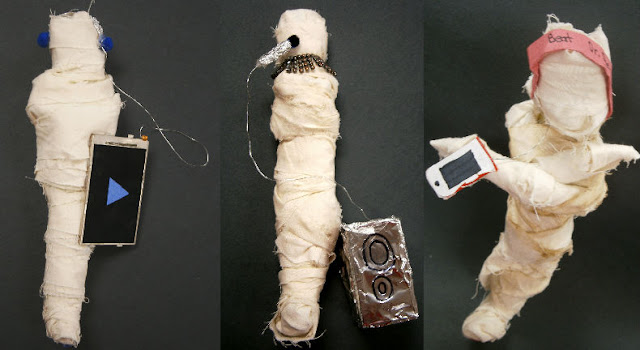Ancient Egyptian Mummies
Students Create Mummy Forms with Modern Accessories
The Sixth Grade Social Studies teachers are currently covering Egypt and I jumped at the chance to introduce them to various Ancient Egyptian arts. We started off discussing mummification and the steps and reasoning behind it. The students loved taking this opportunity to share what they already know about mummies, tombs and Egypt in general (they especially like talking about how Egyptians removed a person's brain when they were to be mummified!). We then set to make our own mummies with a modern twist. We build foil body forms and wraped them in muslin that we cut into bandages and dyed various shades of brown with tea. I got this idea from the
Boise Art Museum where they had their own step by step process. I used my own variation of this lesson, but the basic steps were the same.
Step One: Build a Mummy Form from Tin Foil. Some students used masking tape to hold parts together, others were able to use foil to hold form together
Step Two: (After cutting and tea-dyeing the bandages) Wrap Mummy with various strips of fabric. Add some school glue to the ends to keep wrap in place.
But as an art teacher, I couldn't just let our mummies all look the same tea-dyed brown, so for Step Three: we added personality to our mummies by creating accessories! Each student used mixed media to construct whatever accessories they felt necessary to make their mummy stand out. A lot of students made simple accessories like headphones and hats, and others constructed guitars and parachutes for their mummies. The creative juices were flowing and we had some great results. Here are a few of the finished mummies (these all happen to be musically themed, but there are quite a few other styles amongst the students). I'll be sure to post more photos as the kids finish up adding their details.

Tea Dye Troubleshooting: The mummies in the photos above are a lot lighter in color than the one pictured for "Step Two." That is because I am new to tea dyeing and the class who made these mummies did not leave their bandages in the tea long enough. I found that I needed to use many more tea bags to get the color right on this particular fabric and the bandages need to soak for a few days in order to really get that antique coloring.





